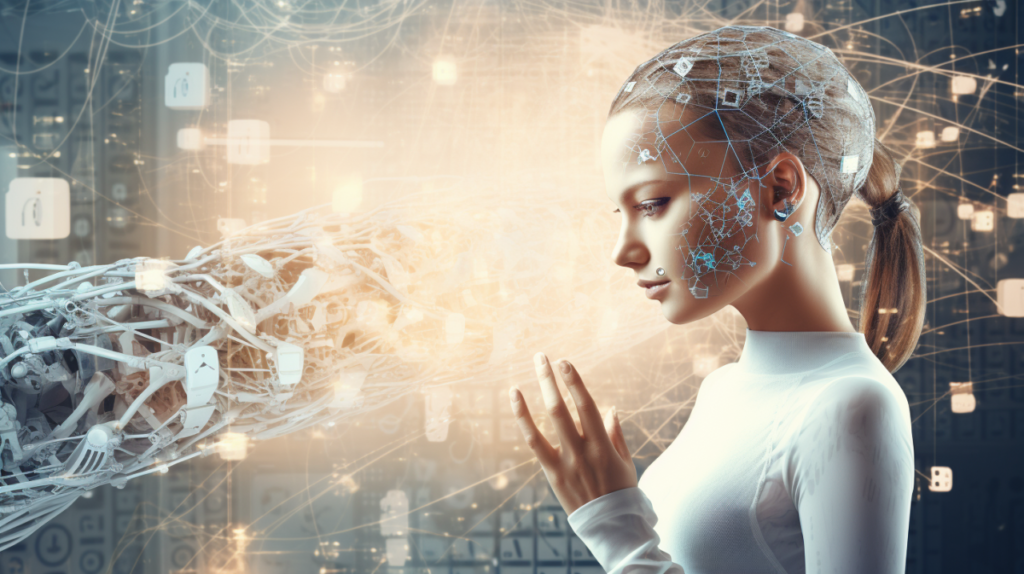
In this article:
- Transformation of the educational landscape through generative AI integration.
- Evolution of e-learning from knowledge distribution to dynamic, AI-enhanced experiences.
- Introduction of Large Language Models (LLMs) revolutionizing learning methods and educator roles.
- Shift from traditional education methods to AI-driven problem-solving and knowledge accessibility.
- Generative AI’s impact on knowledge workers, necessitating the use of AI for effective job performance.
- Redefinition of education from information delivery to immersive, problem-oriented learning.
- Future educational success to rely on integrating learning with training and consulting, enhanced by storytelling and emotional intelligence.
- Necessity for educational methods to adapt, preparing individuals for a future shaped by generative AI.
In the contemporary educational landscape, we are witnessing a radical transformation initiated by the impact of generative artificial intelligence (AI) on learning and the training market offering. This revolution is not just about e-learning but also marks a shift in the business models associated with education, now making no distinction between analog, live, digital, or in-person.
Let’s take a brief look at the history. Since the 90s, e-learning has focused on distributing knowledge packets to an increasingly broad audience on vertical topics, leveraging the distributive dynamics of the internet. The tradition of e-learning is still based on the transfer of knowledge through multimedia sharing, in some cases evolved and enriched by webinars where a certain, limited interaction is expected.
In the next evolutionary phase of e-learning, at the beginning of the 2000s, Artificial Intelligence was introduced, especially dedicated to profiling students entering and exiting training courses. A significant advancement in a business model that is based on the construction of offer catalogs and the measurement of the success of these catalogs, but certainly not revolutionary compared to the scenarios that open up with Generative Artificial Intelligence today.
Today, the introduction of LLM (Large Language Models) is changing the rules of the game. Generative AI not only actively participates in the learning experience but also renews the role of the educator. The crucial issue is that this technology is beginning to bypass the traditional need for content and traditional forms of interaction between teacher and student as the primary means of learning, introducing new forms of accessibility to knowledge itself.
How so? Generative AI facilitates problem-solving, replacing humans in many daily functions. AI matures its role as a knowledge enabler, eliminating the need for students to perform tasks we can now consider ‘traditional’. Luciano Floridi, a renowned philosopher expert in this field, has highlighted how AI decouples the solution of complex problems from human intelligence(1). In this context, education must adapt to teach students how to best use these advanced tools in their daily activities, regardless of the discipline.
This change is particularly relevant for “knowledge workers,” such as financial analysts, mathematicians, insurers, authors, and even teachers themselves. These professionals, operating in the infosphere, will soon find it impracticable to perform their work without the assistance of generative AI.
So, what needs a review? The education paradigm itself. It’s no longer about providing packets of information; education must now immerse students directly in problems, equipping them with the skills to use AI in conversations and projects.
One can imagine a near future where the clear distinction between “training” and “consulting” is nonexistent. The AI that oversees the training path is the same AI that collaborates with the user in a context of “continuous support.”
In summary, I want to share 3 fundamental points on which I imagine the successes of the major training players can be realized:
From learning to training to consulting.
It’s necessary to extend the presence of the teacher, and their AI tools, in the “long life” of the learner. If improvement occurs in stages, with certification checks, the path to the result is constant and applied in the field: “learning by doing” becomes “doing by learning.” The “lessons” are essentially “immersive conversations,” and what today is “office hour,” i.e., the limited availability of teachers to answer open questions from learners outside the training path during daily life where knowledge is applied, becomes “collaboration hours,” an extended time of contact throughout the careers of teachers and learners together.
From Content as Product to Storytelling as Product.
In the e-learning landscape where generative AI will be adopted by all players to provide a -standard- degree of knowledge and a -standard- degree of interaction mode, the differentiating factor to win in the competition will be storytelling, narratives recognizable by the learner as authentic, engaging, and unique. The world of media companies, which builds icons to loyalize viewers and capitalize on the franchise (a striking example is Disney with Marvel or Star Wars, producing every different form of entertainment from cinema to streaming, from theme park to plastic model, from video games to books, to comics) inspires the capitalization of the Brand through its Intellectual Properties: inspired by this model, the teacher is a curator who immerses the learner in narratives through conversational, multimodal, and, ultimately, virtual tools. The e-Learning brand that wants to differentiate itself can avail of “immersive training scenarios,” unique, patented, recognizable that allow extending the business model beyond the training experience. The centrality of emotional training, soft skills. In a “future of work” reality that makes access to hard-skill competences universal through AI intermediation (where the worker does not possess specific skills, they can avail of the appropriately trained AI that takes care of supporting the workflow on their behalf), the real difference between two homologous teams in two competing companies lies in the ability to tackle personal problem-solving, and as a team.
The role of trust, empathy, “trust,” and team play becomes fundamental again.
A “community intelligence” that requires a strong culture of collaboration: a competence that is among the most difficult to teach, and that AI cannot replace without removing free will from people. In conclusion, generative AI is becoming a “commodity” in knowledge working. It’s no longer just a tool but a fundamental element that is redefining the way we learn, work, and solve problems. Faced with this evolving reality, it’s imperative that our educational methods adapt to effectively prepare individuals for the future that is already here.
(1) Luciano Floridi, “The Ethics of Artificial Intelligence”, Oxford University Press, 2023 https://global.oup.com/academic/product/the-ethics-of-artificial-intelligence-9780198883098?cc=it&lang=en&
